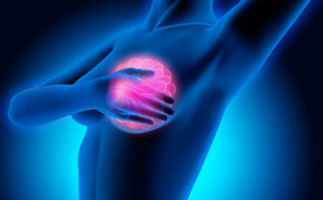
An accelerated course of radiation therapy does not increase complications for patients who undergo breast reconstruction following a mastectomy, new research shows.
Findings of the large, phase III RT CHARM trial (Alliance A221505) will be presented today at the American Society for Radiation Oncology (ASTRO) Annual Meeting.
While radiation therapy following mastectomy to remove breast cancer is known to improve survival rates for certain patients who are at higher risk of recurrence, RT CHARM is the first multi-institutional international study to show that a shorter course of post-mastectomy radiation, combined with breast reconstruction, is safe and effective.
Cutting treatment time nearly in half—from 25 to 16 treatment sessions—could make post-mastectomy radiation a more accessible option for patients.
“Over the past 10 years, we’ve tried to move all patients who need breast radiation to a shorter, more convenient schedule,” said Matthew M.Poppe, MD, FASTRO, the principal investigator of the trial and a professor of radiation oncology at the University of Utah in Salt Lake City.
“But patients after mastectomy who were planning breast reconstruction were the one group where we didn’t have sufficient data to support shorter courses. Now, the results of this trial show we can safely reduce treatment time for these patients to three weeks, without compromising their reconstruction.”
Breast cancer is the second most frequently diagnosed cancer for women in the U.S.
About 40% of people with breast cancer have mastectomies, and of that group, the majority undergo reconstructive breast surgery.
A good portion of patients who get mastectomies also need radiation therapy to the chest wall and lymph nodes, to help prevent their cancer from returning.
Historically, radiation therapy for breast cancer generally occurs over a period of five to six weeks, but recent research has shown a shorter course of treatment is just as effective at preventing the cancer from returning and can also improve patients’ quality of life.
Patients seeking post-mastectomy radiation were typically excluded from these studies, however, due to concerns that the higher daily doses of radiation might increase side effects and impact the reconstructive process.
RT CHARM was designed to test whether that would be the case, Dr. Poppe said.
He and his colleagues enrolled 898 patients with unilateral invasive breast cancer at 209 academic and community-based cancer centres across the U.S. and Canada.
Eligible patients included those with larger tumours (pT3N0) or smaller tumours and invasion of the regional lymph nodes (pT0-2 pN1-2).
The median patient age was 46 years, and all patients were planning immediate or delayed breast reconstructive surgery following post-mastectomy radiation.
Patients were randomised to receive either conventional radiation consisting of 25 fractions delivered across five weeks (50 Gy total; n=449) or hypofractionated radiation consisting of 16 fractions delivered across roughly three weeks (42.56 Gy total; n=449).
Slightly more than half of the patients (51%) received chemotherapy prior to their mastectomies, and 37% received chemotherapy following mastectomy.
Among the 650 patients who completed reconstruction during the study period, 59% had implants alone and 41% had autologous reconstruction using their own tissue, with or without implants.
Researchers followed these patients to document any reconstruction complications, including issues with wound healing, hospital readmission, unplanned re-operation, reconstruction failure or capsular constructure, which involves scar tissue affecting the new breast.
The median follow-up was five years.
Two years after reconstructive surgery, 14% of patients who had the shorter course of radiation experienced complications, compared to 12% of those who had the standard course of treatment.
This difference was considered statistically non-inferior (Z=3.373, p=.00004).
Treatment-related side effects were equally mild for both groups, occurring for fewer than 6% of patients on either treatment arm.
“We expected a complication rate of 25 to 35% based on prior, single institution studies of patients who received reconstructive surgery and radiation,” said Atif J.
Khan, MD, senior author of the study and a radiation oncologist at Memorial Sloan Kettering Cancer Centre in New York.
“It was very exciting to see a complication rate that was nearly half what we anticipated.”
Regardless of treatment schedule, patients experienced fewer complications following autologous versus implant-only reconstruction (8.7% autologous vs.15.5% implant-only, p=.00043).
Within three years of treatment, recurrence rates were similar, with cancer recurrence in just 1.5% of patients who received the shorter course of radiation, compared to 2.3% of those in the conventional arm.
Without radiation, typical recurrence following mastectomy in patients with high-risk disease is 20-30%, said Dr. Khan.
“Radiation therapy after mastectomy saves lives. Patients shouldn’t have to choose between radiation or no radiation based on their desire for reconstruction, or because they can't take six weeks out of their lives,” he said.
Cutting treatment time in half also saves patients time and money.
From conversations with his patients, Dr. Poppe said he already knows how big an impact a shorter treatment course can have on their lives.
“The majority of my patients live two to five hours away from our cancer hospital. Taking five or six weeks of time, uprooting your family or leaving your business behind to move closer to the cancer centre — even though it’s important for survival, it can be out of reach for a lot of patients. When I tell people they can do three weeks of radiation instead of six weeks, you can see their relief.”
Dr. Poppe and Dr. Khan said they hope their findings will encourage more cancer centres to adopt a shorter course of radiation treatment for any patient who has a mastectomy.
“There’s been a slow start to moving to shorter treatment courses after mastectomy, even with no reconstruction,” said Dr. Poppe.
“But now we have robust data, from hundreds of academic and community centres, and from patients with any type of reconstruction, that clearly show the safety and effectiveness of short course radiation.”